

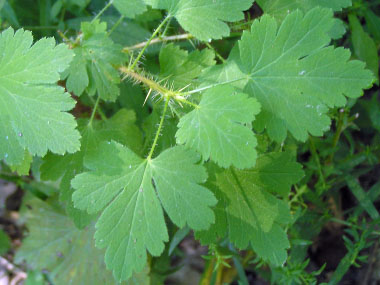
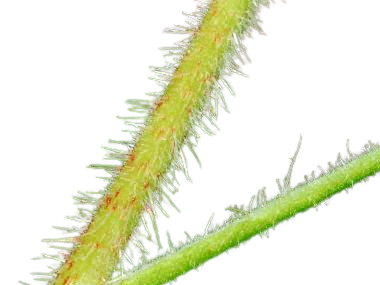
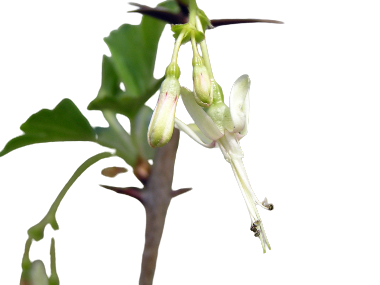
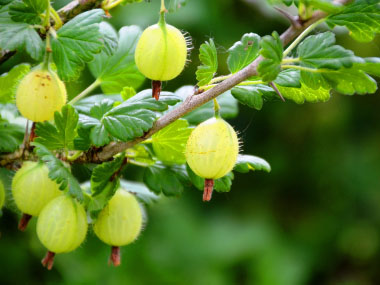
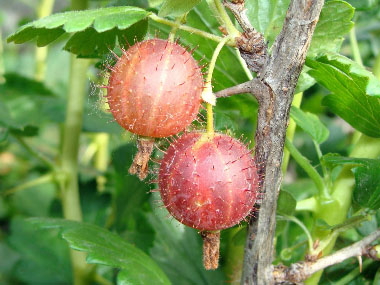
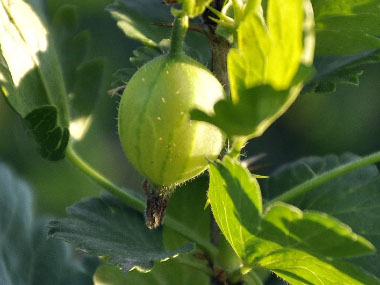
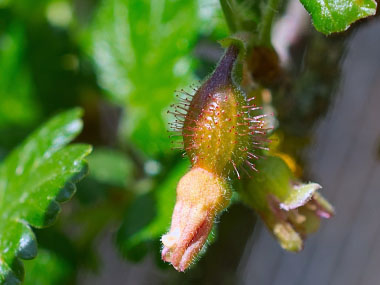
To support our efforts please browse our store (books with medicinal info, etc.).
Prickly gooseberry is native to eastern North America and is in the Grossulariaceae family. There are many similar species of the gooseberry with Ribes hirtellum (Wild Gooseberry)and Ribes oxyacanthoides (Bristly Wild Gooseberry) also being native to this continent. Ribes uva-crispa (European Gooseberry) is found throughout the U.S. and Canada but is native to Europe and Asia. Prickly gooseberry has both prickly and smooth branches on the same plant. The ripe red or purple berries of this plant are always prickly. Despite the prickles on the berries, they are attractive to many birds, including Cedar Waxwings, Catbirds, Robins, and Brown Thrashers. It is a low, straggling, deciduous shrub that branches occasionally. There are no toxic lookalikes although they are easily confused with many other species of gooseberries. In Chippewa, they refer to this plant as the "micidji’minaga’wunj" meaning fuzzy fruit.
Trunk/Bark
The bark is typically grayish-brown; bark of an adult plant is thin and smooth.
Branches/Twigs
Young branches are green, while older branches are gray or brown. They have two kinds of thorns; long thorns measure about 1.25cm (1/2") occurring in groups of 1-3 near the petioles of the leaves (or where the petioles used to be located). Shorter thorns measure about .75cm (1/4") or less and are abundant on major branches, but fewer in number or absent on smaller branches. These thorns are brown to reddish brown and are straight. Twigs have fine hair, but becoming smooth with age. They have a few scattered prickles and glandular hairs. The nodes bear 1–3 spines that measure about 1 cm (3/4") long. In the winter the twigs can be brown, gray, purple, red, or green.
Height
60 to 120cm (2 to 4') tall.
Leaves/Needles
Prickly gooseberry leaves occur alternately along the branches in groups of 1 to 3. Each leaf can be up to 5cm (2") long and across. It is palmately lobed and crenate along the margins. Veins are prominent and radiate from the base. Usually there are 3 to 5 major lobes per leaf with several lesser lobes. The upper surface of each leaf is slightly pubescent to hairless, while the lower surface is pubescent to slightly pubescent. Each leaf is indented (cordate) at the base where the petiole joins the leaf blade. The petioles are usually hairy.
Flowers
Flowers are produced in groups of 1 to 3 near the petioles of some leaves; the inflorescence is either a branched cyme or a short raceme, from which the flowers droop downward. Depending on geographical location they typically bloom anytime from April to June. Each flower is about 0.80cm (1/3") long, somewhat bell-shaped, pale yellow to greenish-white with 5 short, erect petals. They have 5 pale yellow stamens that are a little longer than the petals. A green calyx cups the flower, the 5 sepal lobes are shorter than the tube but longer than the petals. Between the calyx and flower stalk is a green ovary covered in long, straight, stiff hairs.
Fruit
A deep red or purple prickly fruit is produced from each flower. It measures about 1cm (3/4") in diameter. Fruits mature in late summer. Berries ripen from green to light purplish red.
Habitat
Prickly gooseberries prefer part shade and average to moist rich or rocky soil. They can be found in hardwood or mixed forests, thickets, outcrops, floodplains, and in swampy areas. This species can be found in some midwest and throughout the eastern states as well as anywhere from Manitoba to the east coast in Canada.
Edible Parts
The fruit is edible. Gooseberries are high in fibre, vitamins C, B5, B6, copper, manganese, and potassium. They also are rich in antioxidants and fibre. They can be picked while green but need to sit and ripen before using. Young, fresh leaves can be used in a salad or be used as a tea. Do not overharvest from one shrub though otherwise it may cause harm to the production of the fruit.
Other Name
Dogberry.
Recipes
Winter Survival Food Handbook

PDF Plant Magazines
Types of Wild Food
Geographic Zones Seasons
Disclaimer
EdibleWildFood.com is informational in nature. While we strive to be 100% accurate, it is solely up to the reader to ensure proper plant identification. Some wild plants are poisonous or can have serious adverse health effects.
We are not health professionals, medical doctors, nor are we nutritionists. It is up to the reader to verify nutritional information and health benefits with qualified professionals for all edible plants listed in this web site. Please click here for more information.
Why Edible Wild Food?
- Food costs are rising
- Free, wild food is readily abundant
- Wild food adds nutrition to your diet
- Wild food can help treat various medical conditions





